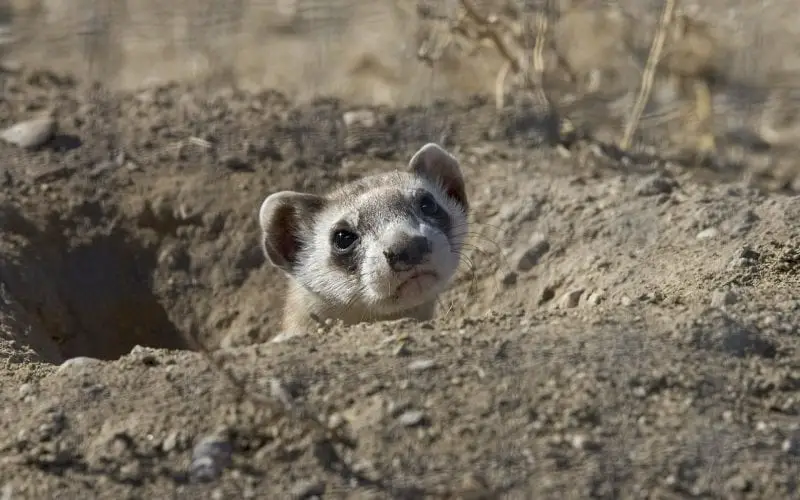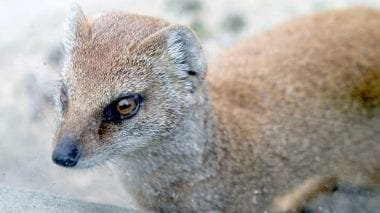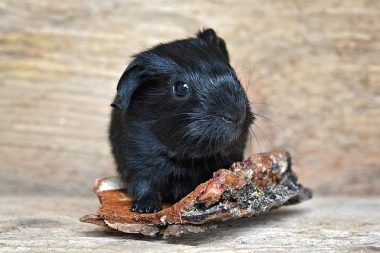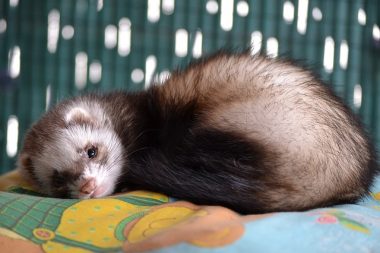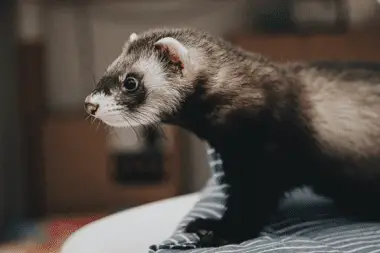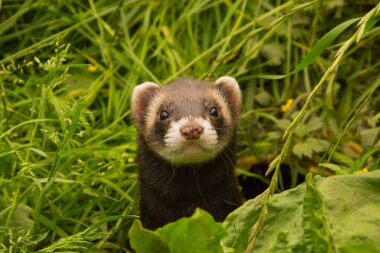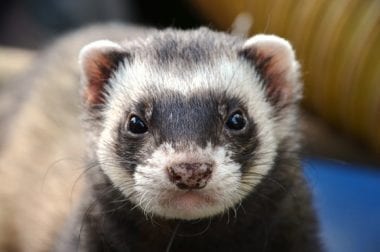Mustela nigripes or the black-footed ferrets are natives to North America & the only ferret species of that region. The black-footed ferret often called the prairie dog hunter or even termed as the American polecat belongs to the Mustelidae family of the order Carnivora. The black-footed ferret has been listed as one of the most endangered mammals of North America by the IUCN due to its limited population.
The Siberian polecat, the European polecat & the black-footed ferrets are the only 3 ferret species existing on Earth. The European polecat is native to England & its surrounding region. The Siberian polecat is home to Western Eurasia & the northern regions of Morocco.
The black-footed ferret was considered extinct until 1981 when it was found on a ranch in Wyoming. Later the U.S. Fish & Wildlife Services launched a captive breeding program in restoring the black-footed ferrets. Various programs conducted by animal welfare organizations in preserving these species including the Smithsonian Conservation Biology Institute have really helped them recover. Currently, with an endangered status, they are highly protected & looked after species in North America.
Facts & Characteristics:
In the black-footed ferrets, the male ferrets are called “hobs” while the female ferrets as “jills” and the young ones as “kits”.
Black-footed ferrets easily adapt to the grassland & the earthy soil surrounding as their body has that earthy color & markings making it easy to blend in with them. They are wiry slender animals with black feet, black-tipped tails & even a black face mask with a short and sleek body. Their skin-coat or fur is yellow-buff in color, shading lighter on the belly and streaking towards white on the ferret’s throat, muzzle & forehead. Their short legs are held with large paws with sharp claws which helps them in digging.
The black-footed ferrets are supposed to have severe hearing & sight problems despite their large ears & eyes.
This decrement has however been rewarded with a great sense of smell which helps ferrets sense & hunts down preys in dark undergrounds or at nighttime.
The size of a black-footed ferret is quite small. Size wise they resemble a mink measuring between 18 and 24 inches (46 to 61cms) in length and with a height ranging from 5 to 6 inches (13 to 15cms). The males in the ferrets are usually a bit bigger when compared to the females & weigh between 1.5 to 2.5 pounds (around 1 Kg).
In earlier times the black-footed ferrets existed in the entire North American grasslands & further to Southern Canada & Northern Mexico. Presently they have shifted from being extinct to endangered species with their limited population thriving in their former range in Arizona, South Dakota, Montana & Wyoming.
Black-footed ferrets are immensely vocal animals. They create different vocal sounds during a particular situation such as a loud babble is an alarm call for warning & a hissing sound denoting fear or agitation. The female ferret creates whimpering sounds in motivating the young ones to abide while the male ferret creates a “chortle” or laugh gleefully to the female ferret when breeding.
Black-footed ferrets are embodied with a fast metabolism & consume a large amount of food equalling to their body size & weight. The ferrets usually hunt & consume one prairie dog in three or four days but again this consumption bound to vary with each ferret & the prevailing climatic conditions.
Learn More about the Black-Footed Ferrets:
The Prairie dog is the most favored food for the black-footed ferrets especially in the wild. With nearly 90% of ferrets consuming the prairie dog, conducted studies have shown that in a year each ferret consumes at least 100 prairie dogs & around 250 prairie dogs for a ferret family. Barring the prairie dog, the ferrets sparingly devours rabbits, birds, squirrels, rodents & even sometimes insects and reptiles.
The black-footed ferrets at the Smithsonian National Zoo are given commercially made carnivorous food such as a meat mix, with rats or mice.
Black-footed ferrets are single animals & prefer remaining single except during the breeding season or in supporting the female fetter when looking after the young ones.
Care & Breeding:
The breeding time of a black-footed fetter is usually in March & April.
The pregnancy period of the female black-footed fetter is around 41 to 43 days and post that period to give birth to a litter of kits.
Each litter size usually is 3 to 4 young ones & in some cases single kits too but randomly litter size of 9 to 10 young ones has also been documented.
It is the female ferret who takes care of & nurtures the young ones or kits.
The kits are feeble & blind at birth with white hair casing their skinny body & weighing just 0.2 to 0.3 ounces (5 to 9 grams).
At the age of 3 weeks, the dark marks of their body start appearing & the young kits start opening their eyes around 35 days after birth.
Black-footed ferret kits become very active as soon as their eyes open while growing at a fast rate.
Kits grow fast & are three-quarter grown in 3-4 months after birth, roughly by July. It is during this period when they start coming out of their underground dwelling to venture above ground. The kits, on completing their nursing period, start depending on their mother just for food. By summer the female ferret starts keeping her semi-grown kits in separate borrows during daytime & gathering them only at the time to hunt. In due course the young kit starts hunting on its own, becoming self-dependent by September.
The Black-footed ferrets become adults at the age of one & their top generative stage is at about 3 – 4 years in captivity.
Black-footed ferrets are carnivorous animals that become active at nighttime. They literally spend most of their time hunting for prairie dogs in underground burrows while spending minimalistic time above ground post sunrise to hunt, finding new borrows, or even mating.
Borrows are the most secure surroundings for the male & the female black-footed ferrets. Borrows help the ferrets to sleep, escape from other attacking animals & store food. They also help the ferrets escape harsh weather while also acting as a complete home security cover when delivering young ones.
The ferrets do not sleep much & travel very less in the winter. Many times the black-footed ferrets have been found remaining underground for weeks, especially in the winter. Being the more active black-footed ferret, the male ferret can easily travel double the distance covered by a female counterpart female ferret.
When in human care the black-footed ferrets could live up to 4 years of age otherwise limited to 3 to 4 years in the wild.
Black-footed Ferrets & the Eco-system:

The black-footed ferret is supposed to be one of the key species in the current ecosystem in the American continent & as the most at-risk animals in the world. The ferrets recovering in the wild implies the resurgence of the healthy grassland ecosystem which helps them to survive.
Due to habitat loss & alien diseases, the recovery of black-footed ferrets is in bad-straits. For survival, the presence of the prairie dog is very important for the ferret along with underground shelter to reside & in raising the young. Without proper grassland sites & protection from any epidemic, this recovery currently remains difficult.
The current population of black-footed ferrets has been possible only due to pushing captive breeding & re-introducing them into the wild. Although great efforts have been put in repopulating the ferrets, habitat loss & alien disease are currently the biggest threat for this species.
For the black-footed ferret family to be more healthy more ferret existence is expected all over the world unlike the current numbers of around 500 ferrets in 17 locations. At least a population of around 3000 ferrets are required in recovering the endangered Mustelidae species.
Conservation of the Black-footer Ferrets:
The WWF is on the job in this regard by bringing back the prairie dog habitat. They have also initiated action in enlarging the ferret population through further growth & protection in the seven habitats located in Northern America.
To help the black-footed ferrets diet the WWF has started protecting the prairie dog population from the plague bacterium found in lethal sylvatic plagues.
Further that, the WWF has also started testing new oral vaccines for prairie dogs along with extending natural environments for the black-footed ferrets by resettling prairie dogs to uninhabited surroundings.
A black-footed ferret has a slender body quite similar to a weasel which helps it to dig into & out of holes & dwellings harboring its primary prey, the prairie dog. They devour rodents, squirrels & mice if a prairie dog is not found, which comprises their diet for survival. The black-footed ferrets are carnivore hunters who hunt their prey in their own borrows while taking cover in prairie dog habitats.
Many prairie dog towns diminished as farmers & ranchers got rid of prairie dogs as they were destructive to farmlands. With the declining prairie dog population, the black-footed ferrets went into extinction. The ferrets were reintroduced into the American habitats only post 1987 when a captive breeding program was launched.Currently, the black-footed ferrets are on the road to regaining their footings yet, it’s far from over. Sadly these animals once available in huge numbers are presently down to a few hundred, remaining currently threatened & endangered due to new regulatory laws.
